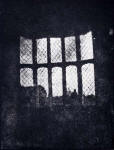|

|
The necessary first breakthrough in photography was in a different,
not eye-centered area, that of making permanent photographic images.
Employing data from the researches of Johann Heinrich Schulze who,
in 1727, discovered that silver nitrate darkened upon exposure to
light, Thomas Wedgwood and Sir Humphry Davy, early in the 19th cent.,
created what we now call photograms. These were made by placing
assorted objects on paper soaked in silver nitrate and exposing
them to sunlight. Those areas of the paper covered by the objects
remained white; the rest blackened after exposure to the light.
Davy and Wedgwood found no way of arresting the chemical action
at this stage, however, and their images lasted only a short time
before darkening entirely.
Photography's basic principles, processes, and materials were discovered
virtually simultaneously by a diverse group of individuals of different
nationalities, working for the most part entirely independently
of one another. The results of their experiments coalesced in the
first half of the 19th cent., creating a tool for communication
that was to become as powerful and significant as the printing press.
Four men figure principally in the establishment of the rudiments
of photographic science.
The French physicist, Joseph Nicéphore Niepce, made the
first negative (on paper) in 1816 and the first known photograph
(on metal; he called it a heliograph) in 1826. By the latter date
he had directed his investigations away from paper surfaces and
negatives (having invented, in the meantime, what is now called
the photogravure process of mechanical reproduction) and toward
sensitized metallic surfaces. In 1827 Niepce had also begun his
association with Louis Jacques Mandé Daguerre, a French painter
who had been experimenting along parallel lines. A partnership was
formed and they collaborated until Niepce's death in 1833, after
which Daguerre continued their work for the next six years. In 1839
he announced the invention of a method for making a direct positive
image on a silver plate the daguerreotype.
Daguerre's announcement was a source of dismay to the English scientist
William Henry Fox Talbot, who had been experimenting independently
along related lines for years. Talbot had evolved a method for making
a paper negative from which an infinite number of paper positives
could be created. He had also worked out an effective although imperfect
technique for permanently “fixing” his images. Concerned
that he might lose the rights to his own invention, the calotype
process, Talbot wrote to the French Academy of Sciences, asserting
the priority of his own invention. He then lost no time in presenting
his researches to England's Royal Society, of which he was a distinguished
member.
All three pioneers, Niepce, Daguerre, and Talbot, along with Sir
John Herschel, who in 1819 discovered the suitability of hyposulfite
of soda, or “hypo,” as a fixing agent for sensitized paper
images and who is generally credited with giving the new medium
its name, deserve to share the title Inventor of Photography. Each
made a vital and unique contribution to the invention of the photographic
process. The process developed by Daguerre and Niepce was, in a
grand gesture, purchased from them by the French government and
given, free of patent restrictions, to the world. Talbot patented
his own process and then published a description of it, entitled
The Pencil of Nature (1844–46). This book, containing 24 original
prints, was the first ever illustrated with photographs.
|

